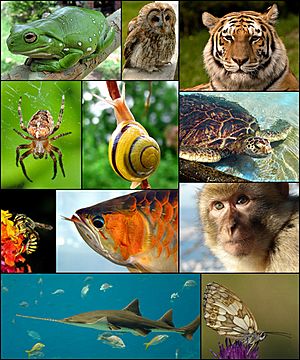Bilaterians facts for kids
Quick facts for kids BilateriaTemporal range: Ediacaran – Recent
|
|
|---|---|
 |
|
| Diversity of bilaterians. | |
| Scientific classification | |
| Kingdom: | |
| Subkingdom: | |
| (unranked): |
Bilateria
Hatschek, 1888
|
The Bilateria are a huge group of animals that have a special kind of body shape. Imagine drawing a line right down the middle of their body, from head to tail. If both sides look almost exactly the same, then that animal is bilateral! This means they have a clear front and back, a top and bottom, and a left and right side. Most animals you know, like humans, dogs, birds, and fish, are bilaterians.
Contents
What Are Bilaterians?
Bilaterians are animals with bilateral symmetry. This means their body can be divided into two mirror-image halves. Think of a butterfly or a human; if you cut them down the middle, the left side looks like the right side. This body plan helps them move forward and find food. It also allows them to have a head with sense organs at the front.
Main Groups of Bilaterians
Scientists divide bilaterians into two main groups based on how they develop as embryos. These groups are the Deuterostomes and the Protostomes.
Deuterostomes: Mouth Second
In Deuterostomes, the first opening that forms in the embryo becomes the anus. The mouth forms later. This group includes some very well-known animals.
- Echinoderms: These are sea creatures like starfish, sea urchins, and sea cucumbers. There are about 7,000 living species.
- Chordates: This group includes all vertebrates (animals with backbones) like fish, amphibians, reptiles, birds, and mammals (including humans!). There are over 63,000 known species.
- Hemichordates: These are worm-like marine animals, often called acorn worms.
Protostomes: Mouth First
In Protostomes, the first opening that forms in the embryo becomes the mouth. This group is incredibly diverse and has many, many species.
Ecdysozoa: Animals That Shed Their Skin
Ecdysozoa are protostomes that grow by shedding their outer layer, called a cuticle. This process is called molting.
- Nematodes: These are roundworms. They live in almost every environment on Earth, from soil to inside other animals. Over 20,000 species are known, but many more exist.
- Arthropods: This is the largest group of animals on Earth! It includes insects, spiders, crabs, and centipedes. There could be anywhere from one million to ten million species.
Lophotrochozoa: Diverse Soft-Bodied Animals
Lophotrochozoa are another large group of protostomes. Many of them have a special feeding structure called a lophophore or a larval stage called a trochophore.
- Annelids: These are segmented worms like earthworms and leeches. There are about 17,000 species.
- Flatworms: As their name suggests, these worms have flat bodies. This group includes planarians and tapeworms. There are more than 20,000 known species.
- Molluscs: This group includes snails, clams, octopuses, and squid. They often have a soft body and a hard shell. There are over 85,000 known species.
- Brachiopods: These are marine animals with two shells, similar to clams, but they are not closely related. Most species are extinct, but some still live today.
Other Protostome Groups
There are also other smaller groups of protostomes, such as:
- Platyzoa: A group that includes flatworms and other small, simple animals.
- Minor Phyla: Like Chaetognatha, which are small marine predators.
The exact number of species for many of these groups is hard to know. This is because many species have not yet been discovered or described by scientists. Also, it's impossible to know how many extinct species there were for most groups.
Related pages
Images for kids
See also
 In Spanish: Bilateria para niños
In Spanish: Bilateria para niños


